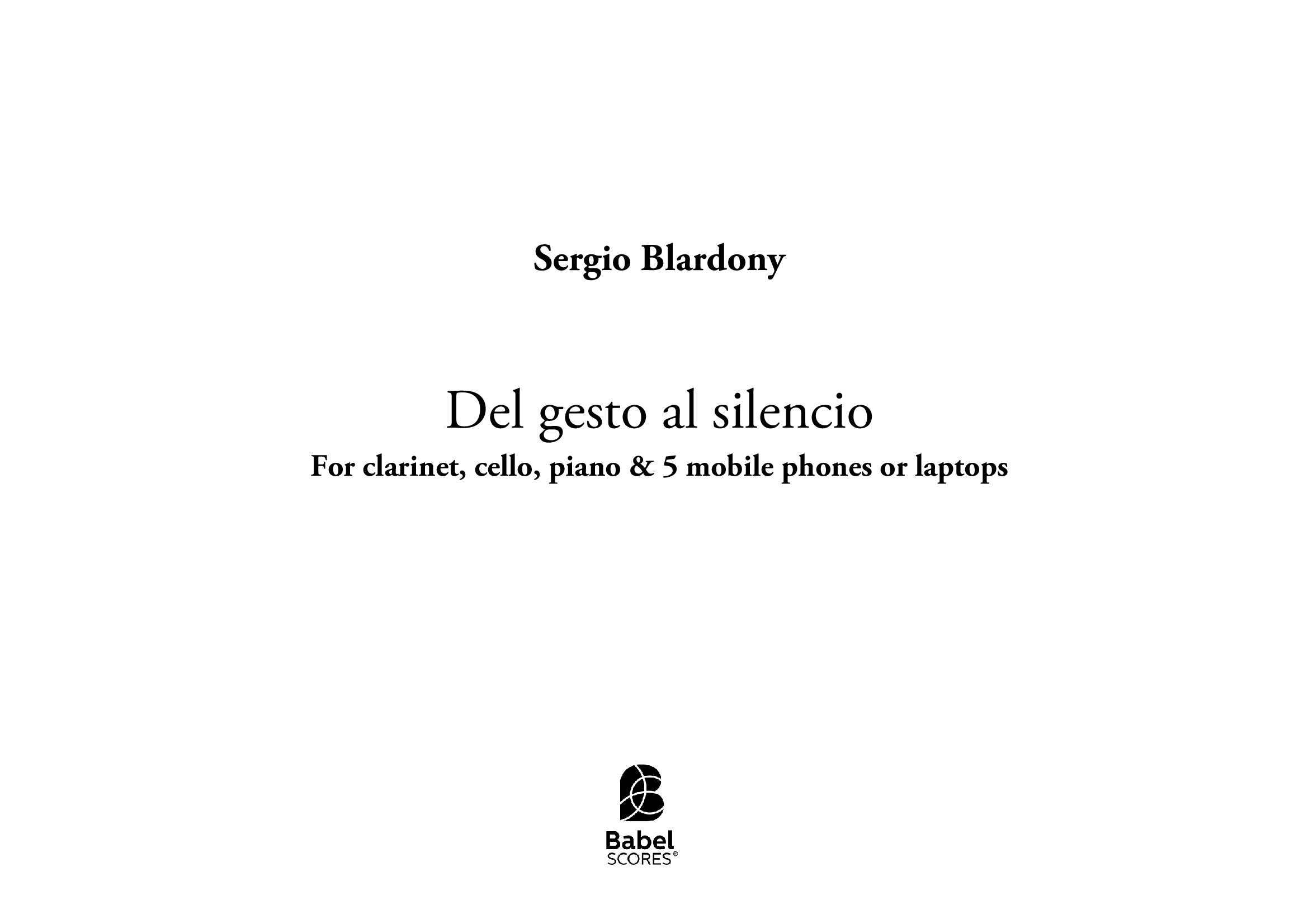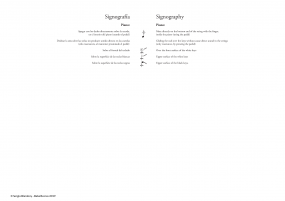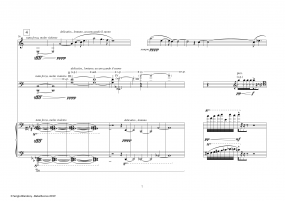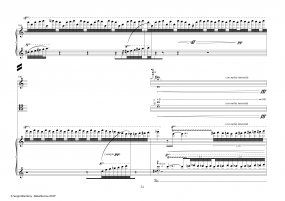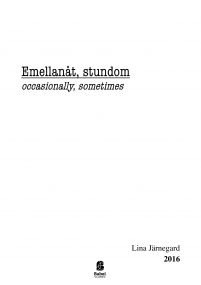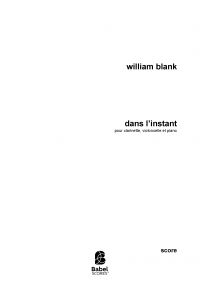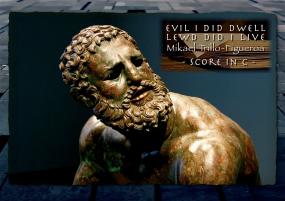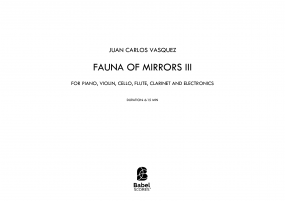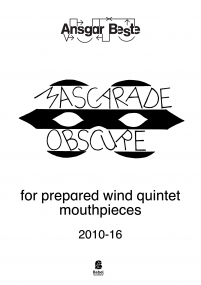Del gesto al silencio
For clarinet, cello, piano & 5 mobile phones or laptops
9,27 €
Printed format (+14,80 € printing and shipping). Colissimo7-14 days aprox.
Digital version (+0,00 €) instant download
When you buy a score, you can contact the composer right here!
Specifications
Region
Europe
Estimated Duration
6 - 10min
Date
2019
ISMN : 979-0-2325-3964-5
Notes on this piece
This is a work that focuses on the Johannes Brahms Trio for clarinet, cello and piano Op. 114, raising two areas of inquiry: on the one hand, the gesture, the romantic movement. That is, how a movement can evolve into a totally different context. In the same way as if it were a resonance that proliferates and transforms the primary musical object into something else. On the other hand, I am interested in working the glaze, the dissolved subject, which is outside the process. Or if desired, the object of the past stopped in time, observed through a translucent veil that lets us see only a part of its importance, just its slight contours and, therefore, is perceived isolated and turned into a new and unreadable matter. Both areas of inquiry are presented in alternation, though never as contrasting elements but as subject that composes a specific and cohesive formal space..
A note, as a reflection
Why this romantic interest now, just now? What I can answer is that we live in a time (or at least it seems that way to me) in which it is interesting and, above all, possible, to revisit an era that in the recent past –I mean the twentieth century mid-avant-garde- it was located, aesthetically in a plane of confrontation with what was called “advanced music”. This meant that any outcropping of this essential period - even if it was considered in a dialectical plane - was perceived as regressive, as a denial of a progressive character that could not contain any element of the past, and less to the essential witness of the rupture that had occurred. Of course, the consolidation of the budgets of the serial avant-garde. Later, the musical postmodernity erased (in many cases in a somewhat crude manner) any possibility of dialectic or dialogue with the past, taking it as a mere object that could be presented out of context, avoiding any teleological or referential sense. With this perspective behind (although with all the uncertainty ahead), I think it is now when the dialogue can be more fruitful and enriching. Obviously, I am not referring to claiming a deed close to that nineteenth-century past or to any kind of “neo-” proposal, but to observe –already without the prejudices imposed by the need for confrontation- how can we dialogue with an era that or not, it still conforms us in some aspects. Putting into dialogue means putting into play, that is, placing the observed object in another place (decontextualiz¬ing) to give it another nature. That alteration will mean doing ours and our time.
One last clarification: it is true that Brahms can qualify as a classical composer within romanticism. However, in him I think there is an obvious stylisation of the gesture. Brahms flees from pathos to immerse himself in a romantic way that he wants to survive, which appeals to create lasting foundations. That is why, for this concrete inquiry into the romantic gesture, I am more interested in this perspective than that of composers whose ideas explored other places, sometimes looking at new languages, without trying to take root.
----- SPANISH ----------------------------------------
Esta es una obra que trabaja sobre el Trío Op. 114 para clarinete, violonchelo y piano de Johannes Brahms, planteando dos espacios de indagación: por un lado, el gesto, la gestualidad romántica. Es decir, cómo un gesto puede evolucionar hacia un contexto totalmente diferente. Del mismo modo que si se tratara de una resonancia que va proliferando y transformando el objeto musical primario en otra cosa. Por otro, me interesa trabajar la veladura, la materia en disolución, lo que queda al margen del proceso. O si se quiere, el objeto del pasado detenido en el tiempo, observado a través de un velo translúcido que nos deja ver sólo una parte de su relieve, casi únicamente sus contornos y, por tanto, se percibe aislado y convertido en nueva e inaprensible materia. Ambos espacios de indagación se presentan en alternancia aunque en ningún caso como elementos de contraste sino como materia que va componiendo un espacio formal específico y cohesionado.
Un apunte, a modo de reflexión
¿Por qué este interés por el contexto romántico ahora, precisamente ahora? Lo que puedo responder es que vivimos en un tiempo (o al menos así me lo parece a mí) en el que resulta interesante y, sobre todo, posible revisitar una época que en el pasado más cercano –me refiero al de las vanguardias de mediados del siglo XX- era situado, desde una perspectiva estética, en un plano de confrontación con lo que se denominó “música avanzada”. Esto suponía que cualquier afloramiento de este periodo esencial –incluso si se planteaba en un plano dialéctico- se percibiera como regresivo, como una negación de un carácter progresivo que no podía contener ningún elemento del pasado, y menos al testigo esencial de la ruptura que había supuesto la consolidación de los presupuestos de las vanguardias seriales. Después, la posmodernidad musical borró (en muchos casos de una manera un tanto burda) cualquier posibilidad de dialéctica o diálogo con el pasado, tomando éste como mero objeto susceptible de ser presentado fuera de contexto, evitando cualquier sentido teleológico o referencial. Con esta perspectiva a la espalda (aunque con toda la incertidumbre al frente), pienso que es ahora cuando el diálogo puede ser más fructífero y enriquecedor. Evidentemente, no me refiero a reivindicar una escritura próxima a ese pasado decimonónico ni a ningún tipo de propuesta “neo-”, sino a observar –ya sin los prejuicios que impone la necesidad del enfrentamiento- cómo se puede dialogar con una época que, queramos o no, todavía nos conforma en algunos aspectos. Poner en diálogo significa poner en juego, es decir, colocar en otro lugar (descontextualizar) el objeto observado para darle otra naturaleza. Esa alteración supondrá hacerlo nuestro y de nuestro tiempo.
Una última aclaración: es cierto que Brahms se puede calificar como un compositor clásico dentro del romanticismo. Sin embargo, en él creo que existe una evidente estilización del gesto. Brahms huye del patetismo para sumergirse en una forma romántica que quiere pervivir, que apela a crear bases perdurables. Por eso, para esta indagación concreta en el gesto romántico, me interesa más esta perspectiva que la de compositores cuyas ideas exploraban otros lugares, a veces atisbando ya nuevos lenguajes, sin pretender echar raíces.
Add to a playlist
- Login to create your own lists
A note, as a reflection
Why this romantic interest now, just now? What I can answer is that we live in a time (or at least it seems that way to me) in which it is interesting and, above all, possible, to revisit an era that in the recent past –I mean the twentieth century mid-avant-garde- it was located, aesthetically in a plane of confrontation with what was called “advanced music”. This meant that any outcropping of this essential period - even if it was considered in a dialectical plane - was perceived as regressive, as a denial of a progressive character that could not contain any element of the past, and less to the essential witness of the rupture that had occurred. Of course, the consolidation of the budgets of the serial avant-garde. Later, the musical postmodernity erased (in many cases in a somewhat crude manner) any possibility of dialectic or dialogue with the past, taking it as a mere object that could be presented out of context, avoiding any teleological or referential sense. With this perspective behind (although with all the uncertainty ahead), I think it is now when the dialogue can be more fruitful and enriching. Obviously, I am not referring to claiming a deed close to that nineteenth-century past or to any kind of “neo-” proposal, but to observe –already without the prejudices imposed by the need for confrontation- how can we dialogue with an era that or not, it still conforms us in some aspects. Putting into dialogue means putting into play, that is, placing the observed object in another place (decontextualiz¬ing) to give it another nature. That alteration will mean doing ours and our time.
One last clarification: it is true that Brahms can qualify as a classical composer within romanticism. However, in him I think there is an obvious stylisation of the gesture. Brahms flees from pathos to immerse himself in a romantic way that he wants to survive, which appeals to create lasting foundations. That is why, for this concrete inquiry into the romantic gesture, I am more interested in this perspective than that of composers whose ideas explored other places, sometimes looking at new languages, without trying to take root.
----- SPANISH ----------------------------------------
Esta es una obra que trabaja sobre el Trío Op. 114 para clarinete, violonchelo y piano de Johannes Brahms, planteando dos espacios de indagación: por un lado, el gesto, la gestualidad romántica. Es decir, cómo un gesto puede evolucionar hacia un contexto totalmente diferente. Del mismo modo que si se tratara de una resonancia que va proliferando y transformando el objeto musical primario en otra cosa. Por otro, me interesa trabajar la veladura, la materia en disolución, lo que queda al margen del proceso. O si se quiere, el objeto del pasado detenido en el tiempo, observado a través de un velo translúcido que nos deja ver sólo una parte de su relieve, casi únicamente sus contornos y, por tanto, se percibe aislado y convertido en nueva e inaprensible materia. Ambos espacios de indagación se presentan en alternancia aunque en ningún caso como elementos de contraste sino como materia que va componiendo un espacio formal específico y cohesionado.
Un apunte, a modo de reflexión
¿Por qué este interés por el contexto romántico ahora, precisamente ahora? Lo que puedo responder es que vivimos en un tiempo (o al menos así me lo parece a mí) en el que resulta interesante y, sobre todo, posible revisitar una época que en el pasado más cercano –me refiero al de las vanguardias de mediados del siglo XX- era situado, desde una perspectiva estética, en un plano de confrontación con lo que se denominó “música avanzada”. Esto suponía que cualquier afloramiento de este periodo esencial –incluso si se planteaba en un plano dialéctico- se percibiera como regresivo, como una negación de un carácter progresivo que no podía contener ningún elemento del pasado, y menos al testigo esencial de la ruptura que había supuesto la consolidación de los presupuestos de las vanguardias seriales. Después, la posmodernidad musical borró (en muchos casos de una manera un tanto burda) cualquier posibilidad de dialéctica o diálogo con el pasado, tomando éste como mero objeto susceptible de ser presentado fuera de contexto, evitando cualquier sentido teleológico o referencial. Con esta perspectiva a la espalda (aunque con toda la incertidumbre al frente), pienso que es ahora cuando el diálogo puede ser más fructífero y enriquecedor. Evidentemente, no me refiero a reivindicar una escritura próxima a ese pasado decimonónico ni a ningún tipo de propuesta “neo-”, sino a observar –ya sin los prejuicios que impone la necesidad del enfrentamiento- cómo se puede dialogar con una época que, queramos o no, todavía nos conforma en algunos aspectos. Poner en diálogo significa poner en juego, es decir, colocar en otro lugar (descontextualizar) el objeto observado para darle otra naturaleza. Esa alteración supondrá hacerlo nuestro y de nuestro tiempo.
Una última aclaración: es cierto que Brahms se puede calificar como un compositor clásico dentro del romanticismo. Sin embargo, en él creo que existe una evidente estilización del gesto. Brahms huye del patetismo para sumergirse en una forma romántica que quiere pervivir, que apela a crear bases perdurables. Por eso, para esta indagación concreta en el gesto romántico, me interesa más esta perspectiva que la de compositores cuyas ideas exploraban otros lugares, a veces atisbando ya nuevos lenguajes, sin pretender echar raíces.
Instrumentation
Clarinet|Piano|Cello
Score Details
Format - A4 / US Letter
Pages - 40
Pages - 40

